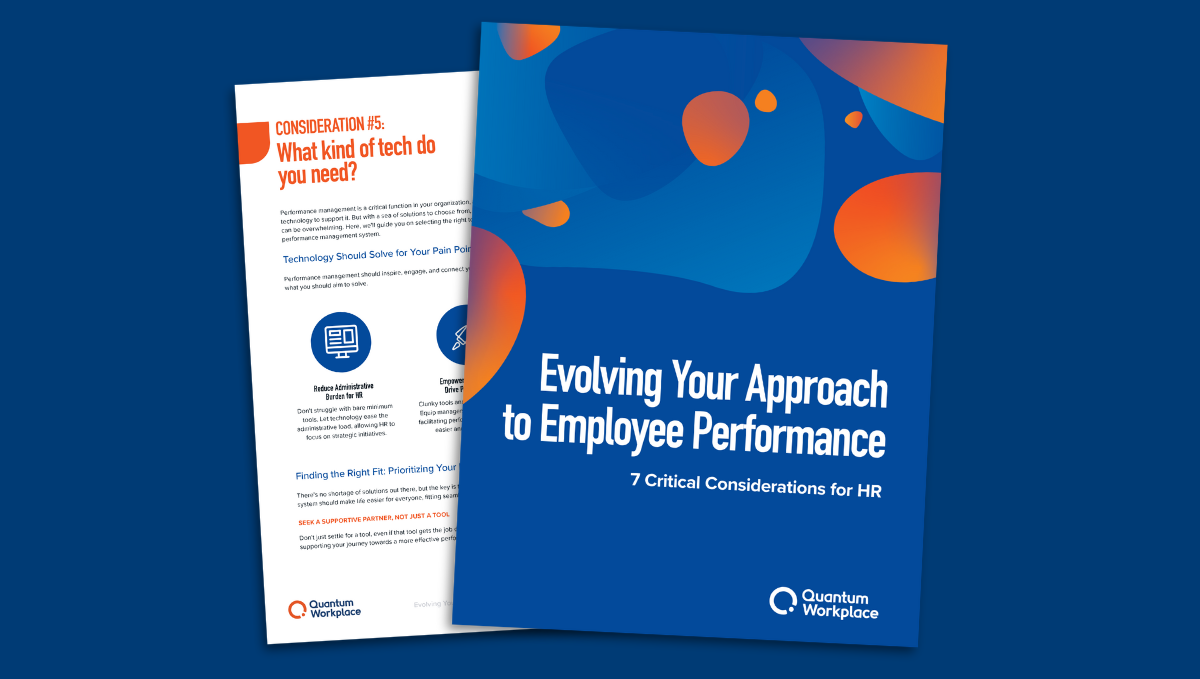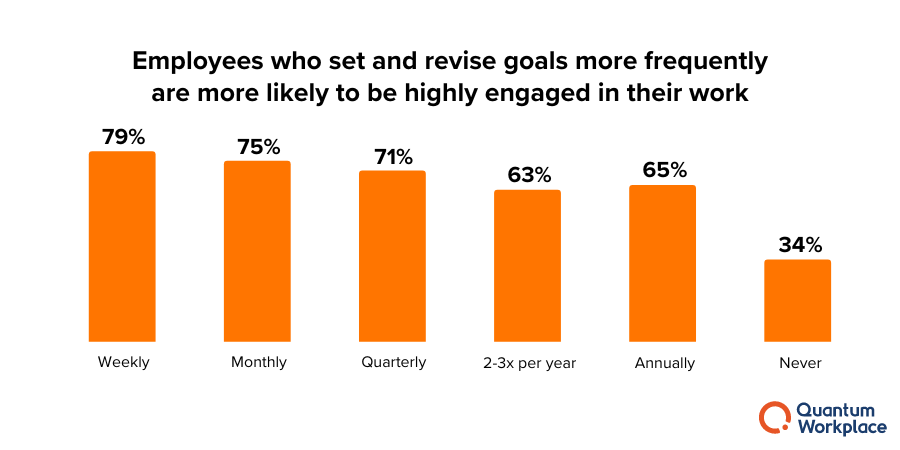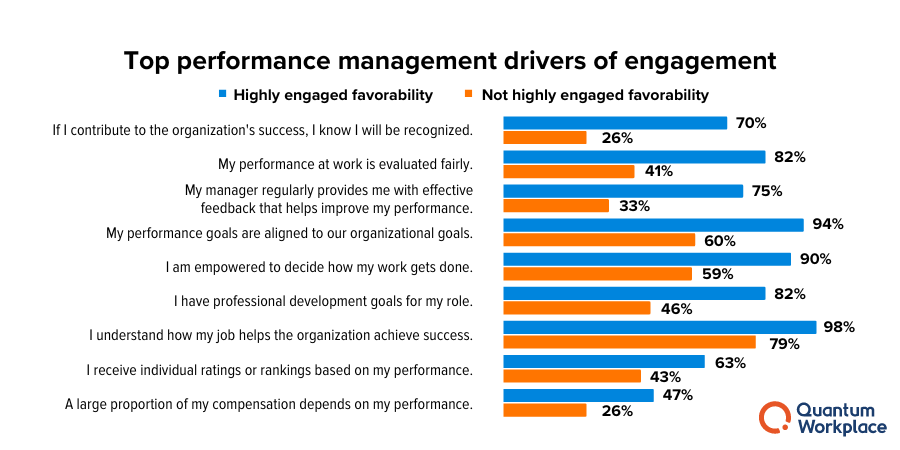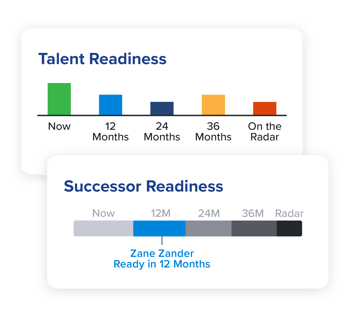In this article, unravel the characteristics that distinguish high-performing teams and how to nurture these traits. Looking to evolve your organization's approach to performance management?


Why do some teams perform better than others? What sets these teams apart from the rest?
Building a high-performing team requires more than just pulling together a group of talented people with the right skills. It requires careful development and the nurturing of key characteristics, behaviors, and best practices.
In this article, we’ll cover what a high-performing team is, what their characteristics are, how to build a high performing team, and how to scale your strategy with performance management technology.
Let’s dive in!
A high performing team is an elite group of individuals who leverage their collective skills, diverse perspectives, specialized expertise, and complementary skills to accomplish challenging goals.
These teams are hyper-focused on achieving clear, outstanding results. They thrive on a foundation of trust, collaboration, and a shared sense of purpose. By harnessing their collective talents and aligning their efforts, high performing teams consistently surpass benchmarks and set new standards of excellence.
But high performing teams aren’t made by magic. With the right approach to performance management, you'll empower them to collaborate, innovate, and produce work at the highest levels.
While every team is different, there are common characteristics that high-performing teams share.
High-performing teams are aligned in their focus, purpose, and priorities. They set team and individual goals that support this shared vision so that their work drives achievement. Goals are not only aligned, but they are clearly defined so everyone knows exactly what they need to do and how to get there.
Our research found that employees who have clearly defined goals are 2X more likely to be engaged at work.

When employees understand how their job fits into the context of the overall goals and mission of the organization, they are more engaged and productive. High-performing teams know their “why” and work together to support a shared vision.
In fact, 98% of highly engaged employees are 98% favorable on the item “my job helps the organization achieve success” and 94% favorable on “my performance goals are aligned to our organizational goals.”

Conflict can quickly derail an otherwise talented and productive team. High-performing teams minimize unnecessary conflict by defining each person’s role and responsibilities clearly. This prevents confusion over project ownership, keeps workflows and deadlines organized, and ensures accountability across the board.
When communication breaks down, conflict arises and performance suffers. High-performing teams set clear expectations and channels for communication so everyone knows when and where to communicate and who they need to connect with. Conflict is normal, but high-performing teams know how to navigate it in a healthy way that doesn't create more obstacles.
High performing teams foster a culture of continuous improvement through open and constructive two-way feedback. Team members feel empowered to share their ideas, concerns, and suggestions without fear of retribution. Managers actively seek feedback from their employees, valuing their perspectives and using the insights gained to drive team growth.
This feedback-driven approach not only enhances individual performance but also strengthens team dynamics, leading to increased collaboration and adaptability. Not to mention, collected feedback can be translated into further development opportunities for employees.
High-performing teams focus on what matters most and spend their time accordingly. They understand that not all work has equal importance or urgency and they manage projects based on what tasks have the highest priority and highest impact. This keeps work aligned with organizational goals and ensures everyone is focused on work that drives growth.
One-on-one meetings serve as a cornerstone of high performing teams, promoting clarity and communication between managers and employees. These meetings go beyond mere status updates, providing a dedicated space for personalized discussions on goals, progress, and challenges.
Managers use this opportunity to understand employees' aspirations, offer guidance, and provide the necessary support to overcome obstacles. By nurturing a strong manager-employee relationship, high performing teams create a sense of belonging and commitment that fuels team success.
The level of collaboration and teamwork required for high achievement depends on trust and mutual respect. Employees on high-performing teams value each other and trust each person to do their job. They respect diversity of thought and experience and recognize those differences make them stronger. This culture of trust helps everyone:
High-performing teams understand that success results from team effort. They celebrate wins together and take opportunities to recognize and show appreciation for each employee’s contributions. This builds a strong culture of collaboration and helps everyone feel valued and connected.
Our research consistently shows that ratings, rankings, and pay-for-performance do not drive employee engagement. But recognition does.
That’s why highly engaged employees were 70% favorable on the item “If I contribute to the organization’s success, I know I will be recognized”.
Even the best teams have room to grow. High-performing teams value feedback and learn from their mistakes. They look for opportunities to grow by nurturing a feedback culture and investing in ongoing employee development. Continuous learning propels growth and keeps teams striving for higher achievement.
High performing teams strike a delicate balance between short-term results and long-term growth. While focused on achieving immediate objectives, they also invest in learning, growth, and development to stay ahead of the curve.
Talent reviews and succession planning are integral components of this approach, ensuring that the team's future leadership remains robust and ready for upcoming challenges.
By prioritizing both short-term wins and sustainable growth, high performing teams are well-positioned to adapt, innovate, and excel in a dynamic business landscape.
What sets high performing teams apart from the rest?
In their pursuit of excellence, these teams go beyond the ordinary - consistently achieving remarkable results.
Let’s uncover the five key things that high performing teams do differently than other teams that enable them to outshine their peers and drive extraordinary success. From fostering a culture of continuous learning to embracing innovative technology and promoting collaboration, these practices can help to unleash the full potential of your teams and propel your organization toward greater achievements.
The only thing that’s certain at every organization is change. But that won’t scare a high performing team. These teams are not afraid to challenge the status quo. Instead, they actively seek out new ideas, encourage innovation, and adapt swiftly to changing circumstances. By embracing flexibility and being open to change, they stay agile, resilient, and capable of seizing emerging opportunities.
But in order to do that, high performing teams need the space, buy-in, tools, and technology to learn big and make mistakes. That’s why high performing teams aren’t always judged by arbitrary KPIs - but on their organizational impact.
Organizational silos are no match for high performing teams. In fact, these teams are notorious for breaking down silos to encourage collaboration across departments, disciplines, teams, and sometimes even countries.
They achieve this by fostering an environment where individuals can freely and willingly share knowledge, leverage each other’s strengths, and work synergistically toward their shared goals. This spirit of collaboration is amplified by the team’s collective impact and strengthens their relationships.
And we’re not talking about old-fashioned sales bells. High performing teams know that meaningful recognition may look different to each individual employee. That’s why they use data to celebrate milestones - both big and small - to proactively and reactively recognize contributions to the larger team.
By doing so, they create a contagious culture of recognition and appreciation which motivates everyone to work smarter and strive for excellence. Not to mention, this supportive work environment makes it easier for the team to share constructive feedback - because these employees know that mistakes are just opportunities to perform better in the future.
High performing teams know that their success is only as strong as the processes and tools that enable them to maximize performance. These teams can’t be bogged down by disparate systems, siloed departmental data, and complicated access issues. To optimize their performance, these teams used tools that enable seamless collaboration, data-driven reporting and analytic capabilities, and automation of repetitive tasks.
These tools free up valuable time to focus efforts on what really matters: strategic growth.
These teams are never going to throw another team member under the bus - figuratively speaking. High performing teams embrace collective accountability by holding each other - and themselves - accountable for the team’s performance.
Their commitments to these high standards are made much easier because of the other aspects we’ve covered - like collaboration, goal setting, and access to tools to help them stay on track.
Building a high-performing team doesn’t happen overnight. It takes commitment and an investment in continuous growth and development. Use the following tips to get started:
In order for employees to feel connected to a team, they need a unified purpose. This is where clear goals and team alignment come into play.
Managers of high-performing teams are always evaluating priorities and team goals to ensure they are effective and aligned. Keep organizational goals top-of-mind by regularly communicating and connecting those goals to the team’s work.
Take advantage of one-on-ones to check in with team members on their progress, identify key priorities, and ensure their work aligns with the overall team goals. This helps create a shared sense of purpose and ensures the team is pulling together in the same direction to drive performance.
High-performing teams have to be nimble and focused—so clear, streamlined communication is essential. Keep everyone on the same page by establishing clear processes and expectations for communication.
For example, teams might use Slack channels for water cooler chats and team updates but rely on project management tools like Asana to house project data, define responsibilities, and track progress and assignments.
Having set communication processes helps prevent conflict and ensures key information is shared with the right people, assignments and responsibilities are clear, and nothing falls through the cracks.
You might also consider creating opportunities for team members to share their expertise and learn from one another. Encourage cross-functional collaboration by organizing workshops, team-building exercises, or knowledge-sharing sessions where employees from different departments can collaborate on projects or discuss industry trends.
This cross-pollination of ideas and skills enhances creativity, problem-solving, and builds a sense of camaraderie.
High performing teams empower their members to make decisions and take ownership of their work. These teams don’t feel nervous to present a new idea, solution, or option to their management team. Instead, managers recognize that the best way to achieve maximum performance is by encouraging employees to take initiative whenever they see the opportunity to do so.
Encourage team members to contribute their ideas, provide input, and make autonomous decisions within their areas of responsibility. This fosters a sense of ownership, accountability, and fosters a culture of trust and empowerment.
Remember that regular recognition for this kind of contribution to the larger team can help employees connect to how their work benefits the larger organization. Which brings us to…
Acknowledging and celebrating individual and group achievements is crucial for building and sustaining a high performing team. Recognition and rewards not only boost morale, but they can reinforce desired behaviors and motivate team members to excel.
Regularly express your appreciation by taking the time to acknowledge the efforts your team members make. Weekly one-on-ones provide an opportunity for you and your team to stay closely connected on the team’s goals, tasks, and achievements. But don’t just recognize big wins. Recognition can happen during key milestones, steady performance, or instances where teams have gone above and beyond their job description.
Remember that the kind of recognition your employees like may differ from employee to employee. Be sure to center the kind of recognition your employees like best by evaluating their preferences over time.
Managers aren’t the only team members who can participate in recognition. Encourage team members to recognize and appreciate each other’s contributions with a “team shoutout” Slack channel or weekly email. This helps to foster a positive and engaging work environment at every level.
If you want consistent outstanding results, build a culture of continual learning and improvement. High-performing teams are curious. They ask questions, explore possibilities, and adapt based on what they learn. When teams are continually building on their knowledge and learning from past mistakes, they are more effective, efficient, and innovative.
Drive team performance by investing in your employees’ growth and development. Identify relevant development opportunities that focus on team needs and priorities, as well as individual goals. Employee development opportunities help employees feel motivated, empowered, and better equipped to do their job.
Building a high-performing team is a marathon, not a sprint. But when you bring together the right mix of skills and experience and nurture these fundamental characteristics of a high-performing team, the payoff will be worth it.
Quantum Workplace has developed a suite of performance management tools that are designed to help you grow, manage, and scale your high performing teams.
Here are some of the key features:
|
|
Setting clear and aligned goals is paramount to the success of high performing teams. Quantum Workplace's performance management software offers goal tracking functionality, empowering teams to set, monitor, and accomplish important goals. With this feature, you can ensure that every employee and every team understands their contributions to organizational success. By aligning individual and team goals with organizational objectives, you create a shared sense of purpose, enabling your team to work collaboratively and effectively towards common goals. |
|
Regular and effective communication is essential for maintaining alignment and connection within your high performing team. Our performance management software facilitates 1-on-1 meetings, providing a platform for ongoing, individualized performance conversations between managers and employees. Whether it's for performance reviews, goal updates, or weekly check-ins, these meetings help managers and employees stay connected, provide feedback, address concerns, and ensure alignment. By fostering clear and consistent communication, you enhance transparency, trust, and collaboration within your team. |
|
Recognizing and celebrating the achievements of your team members is a vital component of building and scaling a high performing team. Our performance management software includes real-time recognition features that allow you to unearth great work and share stories of success. By highlighting and appreciating behaviors and accomplishments aligned with your organization's values, you foster a culture of recognition and appreciation. This recognition not only boosts employee morale but also reinforces the desired behaviors and motivates continued excellence within your team. |
|
Creating a culture of continuous feedback is crucial for the growth and development of your high performing team. Quantum Workplace's performance management software offers two-way feedback tools that enable employees to provide feedback to their managers and vice versa. By facilitating ongoing feedback conversations, you increase trust, enhance communication, and boost performance. Managers can become better coaches, guiding their team members towards improvement and supporting their professional development. This feedback-driven approach empowers individuals and teams to continuously learn, adapt, and excel. By leveraging the capabilities of performance management software, you can effectively manage and scale your high performing team. Quantum Workplace's solution offers features such as goal tracking, 1-on-1 meetings, real-time recognition, and employee feedback tools, all designed to support the growth, alignment, and success of your team as you navigate the challenges of scaling. |

|
Succession planning is a critical component of sustaining high performing teams, and leveraging advanced HR technology enhances its effectiveness. With innovative performance management software, you can identify talent readiness, ensuring a pipeline of capable leaders. Promote growth and development through personalized insights, align with diversity and inclusion plans to build a robust and inclusive leadership pipeline. This technology-driven approach empowers your organization to nurture talent, ensuring a seamless transition and continuity of success. |
|
Talent reviews are essential to scaling high performing teams, and the right performance management software optimizes this process. Gather feedback on talent trajectory to make informed decisions. Understand the state of your talent pool, filtering and focusing on specific groups. Celebrate multiple voices to reduce bias and foster inclusion. Collaborate on next steps to strategize team growth effectively. With technology-enabled talent reviews, your organization can proactively shape its future, unlocking the potential of your high performing teams. |
Want to see how our tools can help support your high performing teams? Check out our performance management solution here. Or, request a demo today.
Published July 25, 2023 | Written By Kristin Ryba